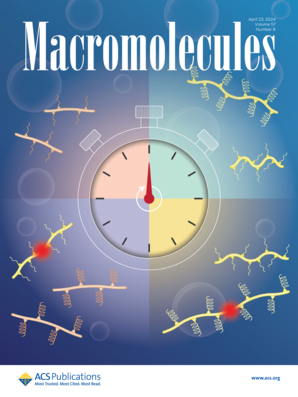通过聚电解质中工程电荷模式的可调谐双层电电容器性能
IF 5.1
1区 化学
Q1 POLYMER SCIENCE
引用次数: 0
摘要
了解聚电解质(PEs)中的电荷分数和电荷顺序对双电层电容器(edlc)的影响对于优化储能装置至关重要。我们采用了由具有相同电荷模式的聚阳离子和聚阴离子组成的反对称pe,消除了反离子效应,并专注于pe -电极的内在相互作用。我们的模拟表明,由于更多的带电物质有助于有效的电荷存储,增加电荷分数可以增强差分电容。块状聚乙烯,其中带电珠沿着聚合物链分组,表现出比规则型聚乙烯和简单电解质更高的积分电容,但由于吸附过程中大量的构象调整导致充电速率较慢。两种类型的pe都促进了过筛的增强,增加了电极表面附近的电荷积累。这些发现强调了电荷分数和顺序对EDLC性能的重要影响。因此,仔细选择PE充电模式可以定制能量存储容量和充电速率,以满足特定的应用需求。本文章由计算机程序翻译,如有差异,请以英文原文为准。

Tunable Electric Double-Layer Capacitor Performance through Engineered Charge Patterns in Polyelectrolytes
Understanding how charge fraction and sequence in polyelectrolytes (PEs) affect electric double-layer capacitors (EDLCs) is crucial for optimizing energy storage devices. We employed antisymmetric PEs composed of polycations and polyanions with identical charge patterns, eliminating counterion effects and focusing on intrinsic PE–electrode interactions. Our simulations revealed that increasing the charge fraction enhances differential capacitance due to more charged species facilitating efficient charge storage. Block-patterned PEs, where charged beads are grouped along the polymer chain, exhibited higher integral capacitance than regular-patterned PEs and simple electrolytes but resulted in slower charging rates due to substantial conformational adjustments during adsorption. Both types of PEs promoted enhanced overscreening, increasing the charge accumulation near the electrode surface. These findings highlight the significant impact of the charge fraction and sequence on the EDLC performance. Careful selection of PE charge patterns can thus tailor energy storage capacities and charging rates to meet specific application needs.
求助全文
通过发布文献求助,成功后即可免费获取论文全文。
去求助
来源期刊

Macromolecules
工程技术-高分子科学
CiteScore
9.30
自引率
16.40%
发文量
942
审稿时长
2 months
期刊介绍:
Macromolecules publishes original, fundamental, and impactful research on all aspects of polymer science. Topics of interest include synthesis (e.g., controlled polymerizations, polymerization catalysis, post polymerization modification, new monomer structures and polymer architectures, and polymerization mechanisms/kinetics analysis); phase behavior, thermodynamics, dynamic, and ordering/disordering phenomena (e.g., self-assembly, gelation, crystallization, solution/melt/solid-state characteristics); structure and properties (e.g., mechanical and rheological properties, surface/interfacial characteristics, electronic and transport properties); new state of the art characterization (e.g., spectroscopy, scattering, microscopy, rheology), simulation (e.g., Monte Carlo, molecular dynamics, multi-scale/coarse-grained modeling), and theoretical methods. Renewable/sustainable polymers, polymer networks, responsive polymers, electro-, magneto- and opto-active macromolecules, inorganic polymers, charge-transporting polymers (ion-containing, semiconducting, and conducting), nanostructured polymers, and polymer composites are also of interest. Typical papers published in Macromolecules showcase important and innovative concepts, experimental methods/observations, and theoretical/computational approaches that demonstrate a fundamental advance in the understanding of polymers.
 求助内容:
求助内容: 应助结果提醒方式:
应助结果提醒方式:


